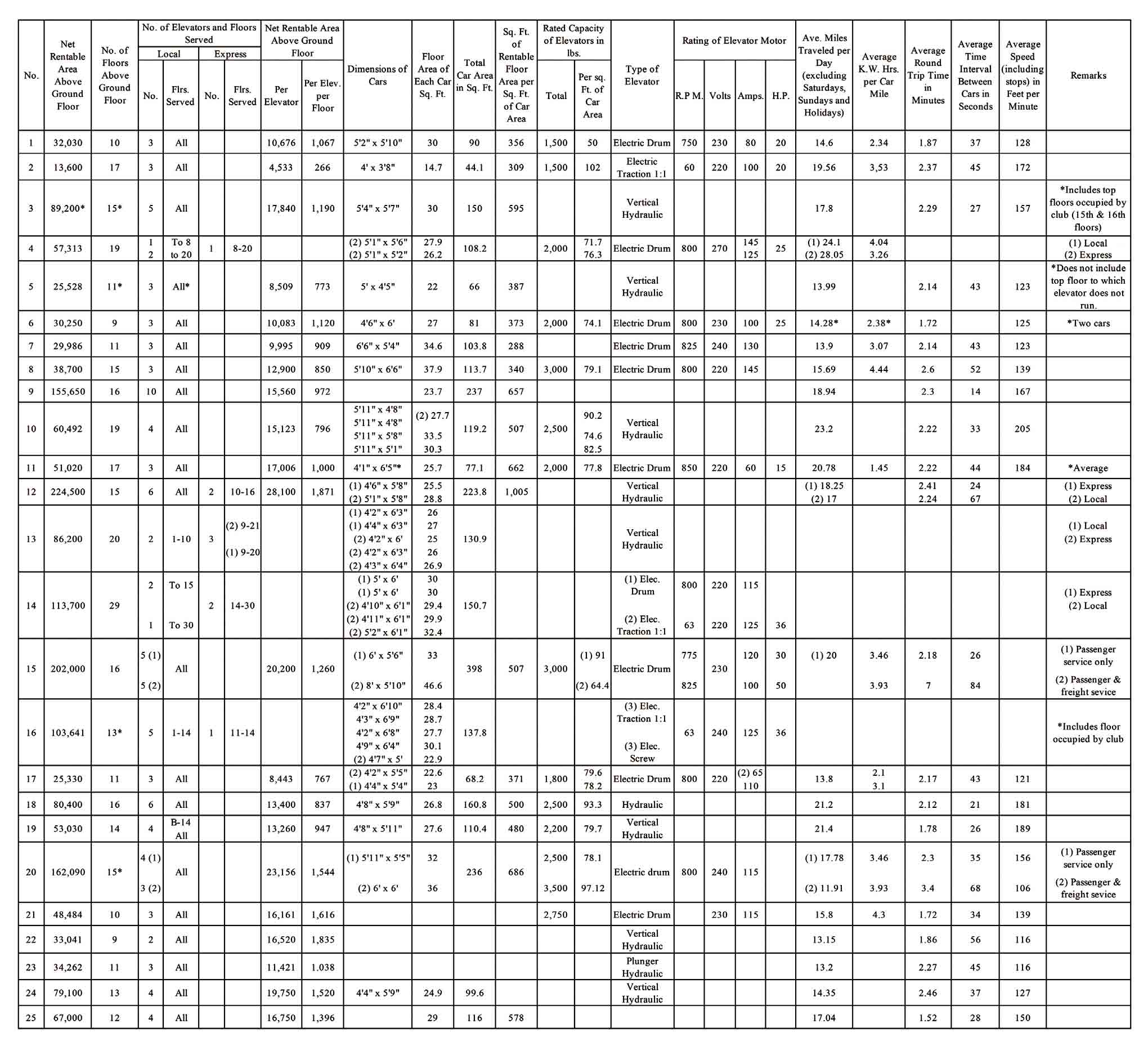Common today, the important information concept began in the elevator industry more than 100 years ago.
“Big data” is one of the dominant intellectual concepts of the early 21st century. The speed with which this approximately 20-year-old concept has gained prominence — and dominance — in a vast array of disciplines and industries is startling. The Oxford English Dictionary defines the noun “big data” as: “Computing data of a very large size, typically to the extent that its manipulation and management present significant logistical challenges; (also) the branch of computing involving such data.” Thus, it concerns massive data sets — and, by implication, the ability to assemble these data sets — and the presence of computers and programs capable of analyzing the data.
A search for “big data and elevators” reveals the various ways the vertical-transportation industry has sought to utilize this new approach to information gathering and analysis. The modern ability to collect significant amounts of elevator data prompts a retrospective question: if we had the opportunity to gather similar data sets from past eras, what would this information tell us about the past, and how might the analysis of this data inform the present? This article examines one of the first “large” sets of operational data compiled, which, while not meeting the contemporary definition of big data, constitutes a unique resource.
In 1912, McGraw-Hill published Commercial Engineering for Central Stations, coauthored by mechanical engineer Edmund F. Tweedy (1876-1949) and electrical engineer Arthur Williams (1868-1937). The book contains a collection of essays describing the use of electrical power in a variety of commercial settings. (Both authors worked for New York Edison Co.) One of Tweedy’s essays is titled “The Passenger Elevator in Office Buildings.” The topic was a logical choice, given the development of the electric drum elevator in the 1890s and the emergence of the electric traction elevator in the early 20th century. The essay opened with a brief history of elevator technology, which included concise technical descriptions of various systems and their strengths and weaknesses. This was followed by a detailed account of elevator use in office buildings and a means of traffic analysis that could be used to determine the number, size and speed of elevators needed for specific settings. The core data set that informed this investigation was assembled through a survey of 25 office buildings primarily located in New York City. In 1913, Tweedy published a revised version of his essay, now titled “Operating Characteristics of the Modern Passenger Elevator,” in the General Electric Review. The data set was expanded in this article, bringing the total number of buildings examined to 27.
It is important to note that Tweedy had no connection with the elevator industry. His lack of direct knowledge and industry experience apparently led him to approach this subject as a basic engineering research project. The thoroughness of his investigation is indicated by the details found in the brief history that introduced his subject (material that could have only been gathered by an extensive literature search and/or interviews with industry members) and the 22 data points he used in his attempt to create a comprehensive data set for each elevator installation. Although Tweedy did not describe how individual data points were collected, the level of detail provided suggests site visits were an important part of his investigation. It should also be noted that, because he did not identify the buildings he surveyed, it is impossible to verify the accuracy of his data.
The data points addressed a broad range of elevator metrics. These included the number of floors and net rentable area above the ground floor. The latter was also expressed in terms of the net rentable area above the ground floor per elevator and net rentable area above the ground floor per elevator per floor. The data also included the number of local elevators and floors served, number of express elevators and floors served, floor area of each car in square feet and total car area (all cars) in square feet for a given building. The final figure allowed Tweedy to calculate the square feet of rentable floor area per total square feet of car area. Elevator capacity was expressed in terms of the overall rated capacity in pounds, and the rated capacity in pounds per square foot of car area. Elevator machine types were identified (vertical hydraulic, plunger hydraulic, electric screw, electric drum and electric traction), as were four aspects of elevator operation: average miles traveled per day (excluding Saturdays, Sundays and holidays), average speed (including stops) in feet per minute, average round-trip time in minutes and average time interval between cars in seconds. The last metric referred to passenger waiting time at the ground floor. Electrical data points included the rating of elevator motors expressed in terms of their rpm, volts, amps and horsepower, and the average kilowatt-hours consumed per car mile.
Tweedy assembled his collected data into a large chart that included a column titled “remarks,” which was used to clarify data points (as needed) (Figure 1). It is interesting to note that the version of the chart included with the 1913 article omitted several data points: rated capacity in pounds per square foot of car area, average speed (including stops) in feet per minute, average round-trip time in minutes, average time interval between cars in seconds and the remarks column. The last four items appear to have been omitted as the result of an editorial decision to “fit” the chart into the magazine. The 1913 chart also included data not found on the 1912 chart, omitted one building and provided data on two buildings not referenced on the earlier chart.
However, while this data clearly appears to have informed Tweedy’s traffic-analysis metrics, he did not “unpack” or overtly analyze the data, nor did he explain the building-selection criteria or the rationale that determined the 22 data points. Thus, the analysis of the data set is left to the reader. One of the first observations is that the set is incomplete. Full data was provided for only four buildings, another four have one missing data point, and the remaining 19 buildings vary in the individual data provided. The building set may be grouped into four categories by the number of stories above the ground floor (Table 1).
The net rentable area above the ground floor ranged from a low of 13,600 sq. ft. to a high of 323,400 sq. ft. However, these figures must be examined in the context of other data points. The building with 13,600 sq. ft. of net rentable area above the ground floor was, in fact, a slender tower, with 17 stories above the ground floor. The tallest building (29 stories) had an equally modest 113,700 sq. ft. of net rentable area above the ground floor. (Note: Tweedy did not define the formula or method used to determine a building’s net rentable area; thus, the gross building size cannot be determined.)
The data set referenced 134 elevators: 115 local and 19 express elevators. Only seven buildings featured express elevators, with their heights ranging from 13 to 29 stories above the ground floor. Information on machine type was provided for 120 elevators, with the variations in type clearly reflecting the fact that the early 20th century was an era of transition (Table 2). While 63% of the total were electric elevators, a comparison of traction elevators to electric drum machines to vertical hydraulic machines (technology that had its origins in the 1870s) reveals the diverse nature of the marketplace in 1912-1913.
The average reported round-trip time ranged from a low of 1.52 to a high of 2.6, with an overall average of 2.1 min. A comparative analysis of this information is challenging, because round-trip time was only reported for 19 buildings, and this data was not evenly divided among the various elevator types. Data was given for nine electric drum installations (average round-trip time: 2.1 min.), seven vertical hydraulic installations (average round-trip time: 2.2 min.) and one electric traction installation (round-trip time: 2.37 min.). In a similar fashion, ample data on elevator speed was given for electric drum and vertical hydraulic installations, with limited data reported for the other machine types (Table 3). This pattern continued with data on the average time interval between cars (Table 4).
The average miles traveled per day ranged from a low of 13.15 (nine-story building) to a high of 23.2 (19-story building). The data was compiled assuming a 10-hr. workday. Finally, Tweedy’s data on car size indicated 39 different sizes, with the smallest car measured at 4 ft. X 3 ft., 8 in. (14.7 sq. ft.) and the largest at 8 ft. X 5 ft. 10 in. (46.6 sq. ft.). This data is intriguing in that elevators in the same building were often reported as not being identical, with differences in measurements of 1-2 in. between individual cars. This raises questions about possible errors in data gathering or possible normative variations in manufacturing during this period.
A complete analysis of this data set would involve consideration of the number of elevators per building, floor size, height, and the interrelationship between these and other data points listed here. Additional information, such as the office-building type and population, are also critical factors. However, as has been noted, these factors are unknown, because Tweedy did not identify the buildings surveyed. Despite these flaws, this early effort at providing “big data” for elevators provides useful insights and suggests a possible structure for the collection and analysis of 19th- and early 20th-century elevator data.
| Number of Buildings | Number of Stories Above the Ground Floor |
| 4 | 9-10 |
| 12 | 11-15 |
| 8 | 16-20 |
| 3 | 21 or more |
| Elevator Type | Number |
| Electric drum | 44 |
| Vertical hydraulic | 41 |
| Electric traction (1:1) | 28 |
| Electric screw | 4 |
| Plunger hydraulic | 3 |
| Elevator Type | Lowest Reported | Highest Reported | Average |
| Electric drum | 125 | 184 | 137 |
| Vertical hydraulic | 116 | 205 | 153 |
| Electric traction (1:1) | – | 172 | – |
| Plunger hydraulic | – | 116 | – |
| Elevator Type | Lowest Reported | Highest Reported | Average |
| Electric drum | 26 | 52 | 39 |
| Vertical hydraulic | 24 | 56 | 35 |
| Electric traction (1:1) | – | 45 | – |
Get more of Elevator World. Sign up for our free e-newsletter.










